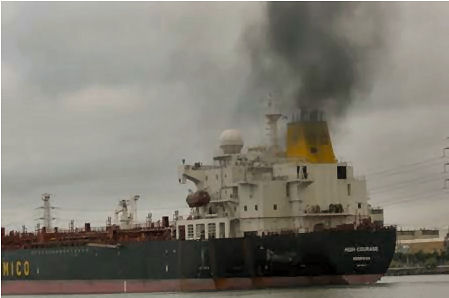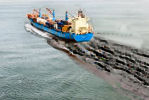More about shipping emissions
 The cruise industry is just as shameless as the rest of the shipping industry.
The cruise industry is just as shameless as the rest of the shipping industry.
The US EPA concludes one cruise ship can emit the same amount of SO2 as 13 million cars and as much soot as 1 million cars [1]. But, despite this, the cruise industry is delaying introduction of new health regulations, trotting out scare tactics such as maritime jobs will be lost, astronomical fare increases etc. The cruise industry even sued US EPA so it could keep burning dirty fuel [2] – and it won as far as I can ascertain.

You might also be interested that there have been no reported Australian studies on health impacts from shipping emissions. In 2012 the Australian Maritime College announced a preliminary study was to start [3] – but it seems to have been spiked as there has been no further reference to it on its website or in the media. The power of the faceless corporations.
Alarmingly, at least in Australia, cruise or container ships are not yet required to switch to cleaner fuel or shore power when in port. Most ports are right in the middle of our cities, so the data I’ve already provided means millions of Austrians are being exposed to this toxic filth every day. Port Phillip Bay has at least six ships per day, all sailing past my place and arriving in the port right under the Westgate bridge, belching fumes over the city as they mostly keep engines running to provide power. See attached image of bulk carrier, the ridiculously named High Courage in the Port of Melbourne.
When the cruise terminal recently moved from Barangaroo in Darling Harbour Sydney to White Bay right on the doorstep of Balmain, residents there soon started complaining of headaches, children in the nearby school falling ill, dirty washing etc [4]. Whilst there has been some indication that cruise liners would switch to shore power whilst tied up at Balmain, I’m yet to hear that it has actually happened. The shipping industry is very canny at avoiding its responsibilities.
However, regarding GHG emissions - a 2008 study of Fremantle and Brisbane ports found Brisbane Port [5] had total GHG emissions of 180,000 tonnes CO2 p.a. Equivalent to emissions from 40,000 cars.
Given the growth of the shipping sector that’s likely to be even higher now. No mention of the other pollutants.
NOTES
[2.] http://www.cruiselawnews.com/tags/emissions
[4.] https://www.amc.edu.au/files/Research_report_web_1.pdf
[5.] ‘Emissions from ships’ ABC RN Science Show 29 August 2009 http://www.abc.net.au/radionational/programs/scienceshow/emissions-from-ships/3062994

 If you think aviation emissions are bad, the even bigger problem is the unregulated shipping industry.
If you think aviation emissions are bad, the even bigger problem is the unregulated shipping industry.
Recent comments